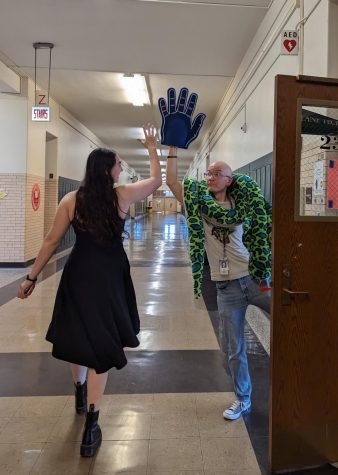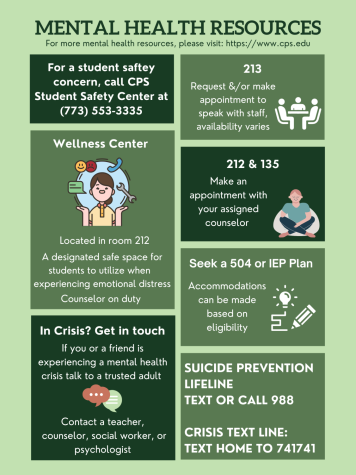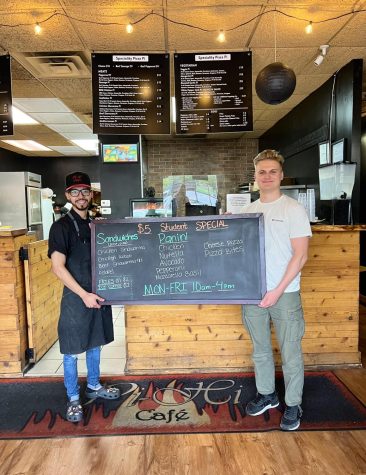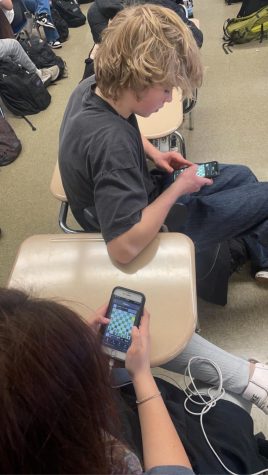Inked Up and Tatted: The stories and stigma behind tattoos
June 22, 2018
When he was 15 years old, computer science teacher Mr. Solin got his first tattoo on his waist in hopes to conceal it from his parents. He successfully kept it hidden for eight months until his shirt came up while he was stretching, exposing his tattoo in front of his dad.
“He told my mom,” Solin said. “My mom broke out in hives, cried. They still want me to stop getting tattooed.”
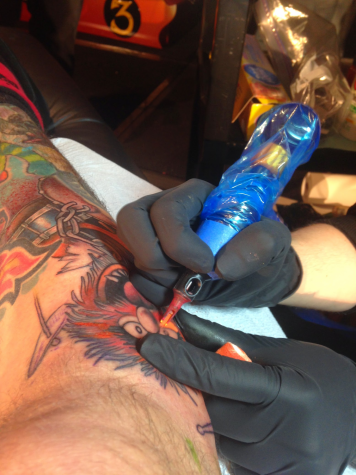
Solin has two full sleeves of tattoos and some covering parts of his legs, back, chest, feet and lip. His tattoos relate to his family, science and other passions.
About three in 10 Americans have at least one tattoo, according to a study conducted by The Harris Poll. The same study found tattoos are even more prevalent among younger Americans with about 47 percent of millennials having at least one.
Emily Jorgensen, Div. 862, has two tattoos. She has one of the date of her dog’s birthday on her left wrist. Her other tattoo, near the left side of her collarbone, is a bird that her grandmother drew for her when she was 12 years old.
“She’s the strongest woman I’ve ever met and I got it right by my heart because I love her so much,” Jorgensen said. “She’s a huge role model to me.”
Some members of Jorgensen’s family, in addition to some of her friends’ parents, have voiced concern as to her getting tattoos at such a young age, she said.
Jorgensen is waiting to tell her grandmother about her tattoos.
“She would get mad because I’m so young still,” Jorgensen said.
In Illinois, the minimum age to get a tattoo is 18 and anyone under 18 is legally not allowed to get a tattoo, even with the consent of a parent or guardian. The only exception is if the tattoo is being done by someone licensed to practice medicine in all branches, according to the National Conference of State Legislators (NCSL).
It wasn’t until 2016 that the city of Chicago followed the rest of Illinois by also lowering the legal age to getting a tattoo to 18, according to ABC 7 Chicago.
DIY “stick and poke” tattoos have grown in popularity among young people as a cheaper alternative to getting a professional tattoo.
Aidan Lallas, Div. 879, has done three small “stick and poke” tattoos on herself. She has done a music note on the inner part of her finger, a sun on her wrist and a puzzle piece on her foot.
“The tattoos that I want are small, so I don’t want to go to a tattoo parlor because they have a minimum, so I just looked up how to do stick
and poke tattoos on myself,” Lallas said. “I was thinking about it for like five minutes, and then I just got all the stuff and I did it.”
“Stick and poke” tattoos are done by manually poking the skin with a needle covered in ink. They often appear lighter than traditional tattoos since the needle doesn’t insert the ink as deeply, according to Vice’s health and science website Tonic.
While stick and poke tattoos can be done professionally, the DIY versions are often done with household items such as a needle, dental floss, pencil, soap and rubbing alcohol, according to the blog “Stick and Poke Tattoos.”
Nearly half of states, including Illinois, require anyone giving a tattoo to be licensed or certified by the Department of Health or another similar agency and follow certain safety and sanitation standards, according to NCSL.
These homemade tattoos can pose an increased risk of contracting infections such as HIV, hepatitis B and hepatitis C compared to going to a professional tattoo shop, infectious diseases specialist Celine Gounder, MD, told the magazine Marie Claire.
Doing the tattoo on herself made the experience more personal, Lallas said.
“I was doing it myself, and I also trust myself,” Lallas said. “I think since I did it, it was not the same experience that other people have.”
English teacher Ms. Thompson didn’t get a tattoo until she was in her 40s. She has two tattoos on her back. One is of an illustrated letter H with flowers in honor of her kids, Hannah, Henry and Harper. Her other back tattoo is of vintage dahlia flowers which she grows in her garden. Her third tattoo is on her wrist and is of a star contained in a circle with the letter H in the middle.
“The tattoos are symbolic of me as a mother,” Thompson said. “The kids were growing and they become more and more part of your life, and it became important to include them in another way other than bringing them up.”
When she was growing up, she said there was a negative stigma attached to tattoos. She said she notices that people are now more open-minded about tattoos.
A study by the American Academy of Pediatrics (AAP) found that in 2008, 29 percent of people believed those with tattoos were more likely to do something most people consider deviant, whereas 24 percent believed this in 2012.
David McNair is a tattoo artist at Chicago Tattoo and Piercing Co. in the Lakeview neighborhood. He is 67 years old and has been a professional tattoo artist for 31 years.
“It’s much more acceptable today,” McNair said. “People of all walks of life are getting them.”
McNair started tattooing himself and getting tattoos when he was about 14 years old.
“There was a lot of prejudice for a long time,” McNair said. “I was considered a social deviant and today, I’m trendy.”
Although social acceptance of tattoos has increased, there may still be repercussions when seeking employment or educational opportunities, according to the same AAP study.
“There was zero chance that getting tattooed was going to make getting a job easier, so I thought a lot about it,” Solin said.
Before working at Lane, Solin worked at Northside College Prep for 11 years. During his job interview for Northside, he wore a suit to cover up his tattoos. When he was hired, he brought up his tattoos and explained they were inoffensive and that his tattoos pertained to his family and passions, he said.
By the time he was hired at Lane, those who hired him already knew about his tattoos.
“Lane is a very open place and that’s one of the things I love about it,” Solin said. “I don’t feel like I’m judged for my tattoos here. I feel like they’re just a part of who I am, and I’m judged for the work that I do, which is what I want.”
Carissa Meredith, Div. 855, has two large tattoos — one of a snake on her ribs and the other of a fairy sitting on a blossom tree branch on her stomach. Both of them relate to her grandma.
The placement of the tattoos was her main concern when deciding to get them because she hopes to be a veterinarian in the future, she said.
“I want my whole body covered but I had to keep in mind future careers,” Meredith said. “That’s why I got them on my center body instead of arms because I want to work at a professional field and people have that stereotype with people with tattoos.”
Since Thompson got tattoos well into her career, she said it allowed her to have already established herself professionally, so they had little impact on how people perceived her in the workforce, she said.
“Regardless of what our freedoms should be, and how we should be judged, there are people who would see them and they might make a quick judgement or perception of you,” Thompson said. “When considering getting one, you should consider it very carefully with regard to what you’re going to do professionally.”
Thompson said if her children were to ask her about getting tattoos, she would tell them to wait until they were older.
“I think that when we’re younger, things that seem really important might not be in a very short period of time,” she said. “I would hate for anyone to have regret about something that they chose to do when they were really young.”
Although Solin said he wouldn’t get the tattoo that he got when he was 15 now, he isn’t going to get it removed.
“I like that over time, as you build up a lot of tattoo work on you, it tells a story,” Solin said. “When I see it, it brings me back to when I was 15 and it reminds me of what I was feeling when I was 15. It’s kind of like a little time machine.”
For people thinking about getting tattoos, Solin said to be prepared to spend money, find an artist that resonates with the style of tattoo you want and don’t do it spontaneously.
“Give it some thought,” McNair said. “Don’t be influenced by your peers or just get one because everyone else has one.”
While social acceptance of tattoos has increased, people with tattoos can still experience negative stigma as tattoos can often be associated with gangs, prisons and violence.
Because of his tattoos, Solin said he finds some people are surprised when they find out he is a computer science teacher. He said he takes these opportunities to get to know people who have negative views of people with tattoos so it can potentially change their outlook on new people they meet.
“When I hear people say, ‘I don’t like tattoos’ that statement bothers me a lot,” Solin said. “Tattooing is just another medium of art. Skin is the canvas, but it’s just art.”
As someone who hasn’t given much thought to tattoos for most of her life, Thompson said she likes how extremely personal tattoos can be.
“I’m surprised myself that I have them,” Thompson said. “I’ve really enjoyed designing and thinking about what goes on my body, and I feel like it enhances who I am and tells a story that no one else has.”


